mayko
International Hazard
    
Posts: 1218
Registered: 17-1-2013
Location: Carrboro, NC
Member Is Offline
Mood: anomalous (Euclid class)
|
|
Honey-Based Pyrotechnic Mixtures
Introduction
A recent paper [1] explored pyrotechnic mixtures using honey as a fuel. These compositions (and their hazards) are described in alchemical texts, and
the authors propose they are intermediates between earlier medicinal preparations and gunpowder:
| Quote: | | Early steps toward the development of gunpowder are evident in 10th century manuscripts, which detailed mixtures, including sulfur, potassium nitrate,
and a carbon source, that could potentially deflagrate. [..] Later works identified an “elixir” containing honey, potassium nitrate, and sulfur,
which were combined and combusted to great effect. Such mixtures were responsible for injury and property loss, and warnings were given in the Taoist
text “Classified Essentials of the Mysterious Tao of the True Origins of Things” against their preparation: “Some have heated together sulfur,
realgar, and saltpeter with honey; smoke (and flames) result, so that their hands and faces have been burnt, and even the whole house (where they were
working) burned down.” Similar warnings are repeated in later 13th century Latin sources “Beware lest the flames set the house and roof on
fire.” |
| Quote: | | The greatest achievement of the Chinese alchemists was the discovery of gunpowder and its application to pyrotechnics and warfare. The alchemy of
China was primarily focused on elixirs of immortality, which can be seen in the Chinese word for gunpowder, huǒ yào, which has been translated
literally as “fire drug”. Chinese texts from the 16th century make reference to the use of this “fire drug” for its medical application
against ringworm, worms, and insects. |
The authors have optimized such a mixture as an educational demonstration (and given examples of suboptimal mixes as well). I decided to try them out.
Materials
Potassium Nitrate
Sulfur (powdered)
Honey (store brand, “US Grade A Clover”)
Safety
Oxidizer and fuel are mixed and ignited, with all the usual hazards. Do not scale up past 10 grams.
Most mixes contain sulfur, and sulfur dioxide fumes are released during combustion; proper ventilation is necessary.
The ceramic dish used for the combustion is prone to breakage. (“Many a good dish was lost while we were investigating this”, one of the authors
told me.)
Procedure
| Code: |
0 I II III IV
"No Flames Observed" "Short delay and vigorous reaction. (Reccomended)" "Long delay and excessively vigorous." "Very vigorous." "Excessively Vigorous."
Honey Parts by mass 1 3 1 15 1
Sulfur Parts by mass 1 1 0 10 1
Nitrate Parts by mass 0 6 1 75 1
Honey by mass 5 3 5 1.5 3.33
Sulfur by mass 5 1 0 1 3.33
Nitrate by mass 0 6 5 7.5 3.33
mol Carbon: 0.13 0.081 0.13 0.040 0.090
mol Sulfur: 0.16 0.031 0 0.031 0.10
mol Oxygen: 0 0.18 0.15 0.22 0.099
Oxygen Balance (ie, ½ * O/(C + S) ) 0 0.79 0.55 1.55 0.26
|
Table 1; Full calculations: Attachment: honeyPyrotechnic.xlsx (8kB)
This file has been downloaded 154 times
The paper gives five different mixtures, four of which will deflagrate (Table 1). They contain sulfur, potassium nitrate, and honey in various
proportions. These are mixed to total 10 grams and heated in a ceramic dish from below with a bunsen burner, using good ventilation.
To try to quantify their reactivity, I calculated an index of oxygen balance as the molar ratio of oxygen to oxidizables (ie, carbon and sulfur).
According to the nutritional information, a 21 gram tablespoon of honey contains 17 grams of sugar, or 81%. This sugar is mostly in the form of
glucose and fructose, both 180.2 grams/mol. These data allow a calculation of 4.5mmol carbon per gram of honey. For comparison, modern gunpowder has
an oxygen balance of 0.71 by this calculation.
Results
I didn’t try the one which is sulfur and honey in equal portions, because if I’m going to be dodging plumes of sulfur dioxide there had better be
some fire to show for it.
I
3.02 g honey, 6.00 g potassium nitrate, and 0.99 g sulfur were mixed; as described, they formed a putty. This began to liquify when heated, and
became a bright orange-red color at the edges. A lot of sulfur vapor was visible right before ignition. It burned with a very smokey flame and formed
molten globules in the burning mass. It left a great deal of soot on the dish, as well as a residue of light yellow solid.
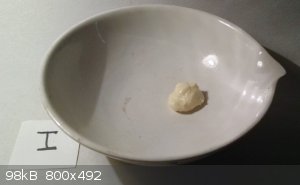
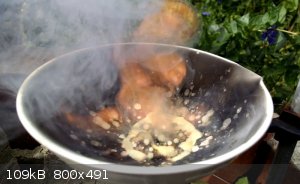
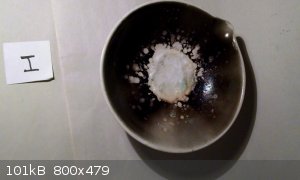
II
5.05 g honey and 5.01 g potassium nitrate were mixed; the final product was quite runny. It did take roughly twice as long to ignite as did I; a lot
of water was driven off and the sugar began to char before ignition. Once on fire, it burned very quickly in a single red flash. The residue was sooty
and hygroscopic. Without sulfur, this one smelled a lot better than the others.
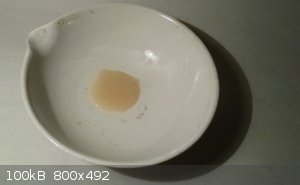
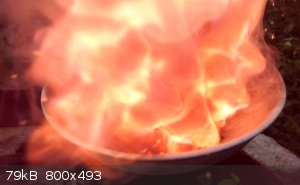
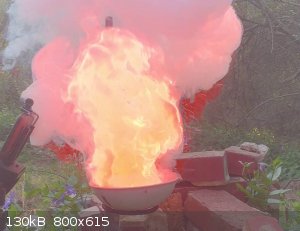
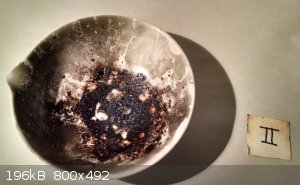
III
1.52 g honey, 7.50 g potassium nitrate, and 0.99 g sulfur were mixed; this was spongy and resembled scrambled eggs. This also took a while to start,
charring a bit first. It ignited forcefully but only burned on the bottom of the mass; the top was mostly untouched. The dish shattered; there was
unburnt mix and conspicuously little soot on the shards.
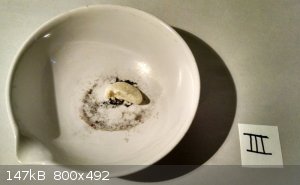
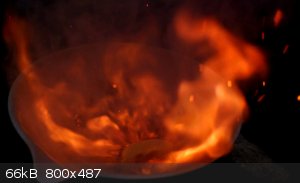
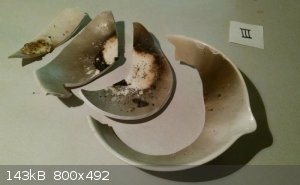
IV
3.36 g honey, 3.34 g potassium nitrate, and 3.32 g sulfur were mixed; this was very thick and sticky. This remained sweet-smelling while heating, and
only smelled sulfurous once it caught fire. Whereas III behaved like a solid pancake on a cushion on flame, this burned from the edge in, liquifying
and looking rather like burning wax. It burnt with relatively little force but cracked this second dish. The residue was sooty and smelly.
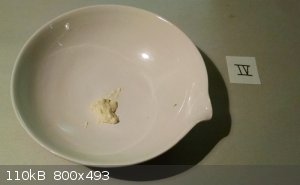
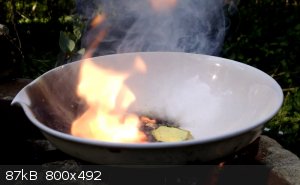
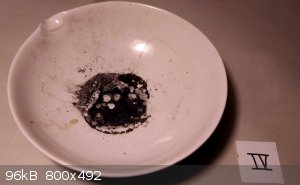
Discussion
Honey can serve as a fuel in energetic mixes, though the water it contains must be heated off. The four proportions given differed in their
qualitative behavior and in relative violence but I actually didn’t consider the suboptimal ones to be as outrageously dangerous as the authors did.
The combustion was typically sooty, which makes sense considering that fuel exceeds oxygen in most of the mixes. The only mix where oxygen exceeded
fuel was III, and this had little soot in its residue, though it also broke its dish and didn’t fully burn. III is also interesting because its 15
fuel : 10 sulfur : 75 nitrate imitates the formulation of modern gunpowder, while having a dramatically different oxygen balance. This happens because
the mass of honey is padded with water, both as a solvent and within the carbohydrate molecules. The optimized ratio is the one whose oxygen balance
is closest to that of modern gunpowder.
References
[1] Wolfenden, Adrian V., and Nathan L. Kilah. 2018. “Ancient Alchemy in the Classroom: A Honey-Based, Deflagrating Pyrotechnic.” Journal of
Chemical Education 95 (8): 1350–53. https://doi.org/10.1021/acs.jchemed.7b00978.
Attachment: Wolfenden, Kilah - 2018 - Ancient Alchemy in the Classroom A Honey-Based, Deflagrating Pyrotechnic.pdf (3.3MB)
This file has been downloaded 179 times
al-khemie is not a terrorist organization
"Chemicals, chemicals... I need chemicals!" - George Hayduke
"Wubbalubba dub-dub!" - Rick Sanchez
|
|
|
underground
National Hazard
   
Posts: 692
Registered: 10-10-2013
Location: Europe
Member Is Offline
|
|
Everyone who knows how to make rocket fuel from kno3 knows it. It is well known from ages. Corn syrup, glucose syrup and actually any kind of sugar
syrup will work, just like honey.
|
|
|
|